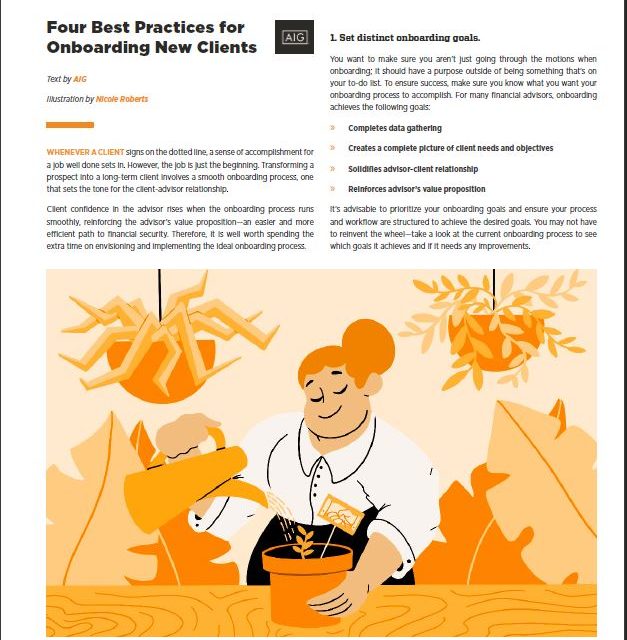
FREE 14.1 – VIEWS – Four Best Practices for Onboarding New Clients
Client confidence in the advisor rises when the onboarding process runs smoothly, reinforcing the advisor’s value proposition—an easier and more efficient path to financial security. Therefore, it is well worth spending the extra time on envisioning and implementing the ideal onboarding process.
To view the full article please register below:
FREE 14.1 – VIEWS – Four Best Practices for Onboarding New Clients
Text by AIG
Illustration by Nicole Roberts
Whenever a client signs on the dotted line, a sense of accomplishment for a job well done sets in. However, the job is just the beginning. Transforming a prospect into a long-term client involves a smooth onboarding process, one that sets the tone for the client-advisor relationship.
Client confidence in the advisor rises when the onboarding process runs smoothly, reinforcing the advisor’s value proposition—an easier and more efficient path to financial security. Therefore, it is well worth spending the extra time on envisioning and implementing the ideal onboarding process.
1. Set distinct onboarding goals.
You want to make sure you aren’t just going through the motions when onboarding; it should have a purpose outside of being something that’s on your to-do list. To ensure success, make sure you know what you want your onboarding process to accomplish. For many financial advisors, onboarding achieves the following goals:
- Completes data gathering
- Creates a complete picture of client needs and objectives
- Solidifies advisor-client relationship
- Reinforces advisor’s value proposition
It’s advisable to prioritize your onboarding goals and ensure your process and workflow are structured to achieve the desired goals. You may not have to reinvent the wheel—take a look at the current onboarding process to see which goals it achieves and if it needs any improvements.
With this information in hand, create repeatable processes and workflows that take each client through a consistent, standardized procedure during onboarding. Create timelines and redundancies to ensure that no part of the process falls through the cracks. Assign staff members as owners of specific tasks and make sure that all client information and communications are uploaded into your customer relationship management tool.
2. Determine your information gathering process.
Setting your client up for success involves information collection, which is routine to advisors but can seem overwhelming to new clients. Make the process more manageable by balancing information collection with relationship building. Take this time to talk to clients about topics that are outside of their financial details in order to build a complete picture of their goals, life situations, spending habits, financial situations and risk tolerances. Information gathering starts with an action plan checklist that aligns data types, formats, timelines and actions. The gathering of most information should occur outside of scheduled meetings, so valuable face-to-face time is not wasted. However, use the first client meeting to emphasize the importance of having the information on hand.
A data gathering checklist should include:
- Data types: financial, personal and investment
- Formats: paper, spreadsheet and digital
- Timelines: order in which data needs to be received to facilitate account openings, account transfers and portfolio changes
- Client actions: authorize account openings, transfers and discretion Establishing regular communications with a client builds confidence in the client and affirms they made the right choice.
3. Onboard your clients’ spouse, significant others, children and family.
Getting to know your client’s family is a crucial part of the onboarding process—it’s critical to understanding the financial dynamics at work so that all parties are working towards the same goal. If you are onboarding retired clients, it is especially important to gather information about adult children and grandchildren, as well as the ways that the clients might want to help their family financially.
When working with a couple, ensure both spouses are involved. Usually one spouse tends to act as the family’s chief financial officer. The other spouse is usually content to let that person be in charge of the finances and investments. But by ensuring that both spouses are involved and informed, you can cement your relationship and ensure the lines of communication between everyone is open. In the event of an untimely illness or death, it is important that the other spouse be aware of the goals of the investment portfolio and the investment strategy used to achieve it. That can also help in retaining assets should a client pass away.
4. Reinforce your value proposition.
Once the onboarding process is complete, reach out to the client to let them know that together you have achieved a milestone in the journey to financial security. This reinforces your value proposition as an advisor, and lets the client know that they are making progress. By exceeding expectations, you and your team can get new client relationships off to a good start and create the building blocks of an enduring relationship.












